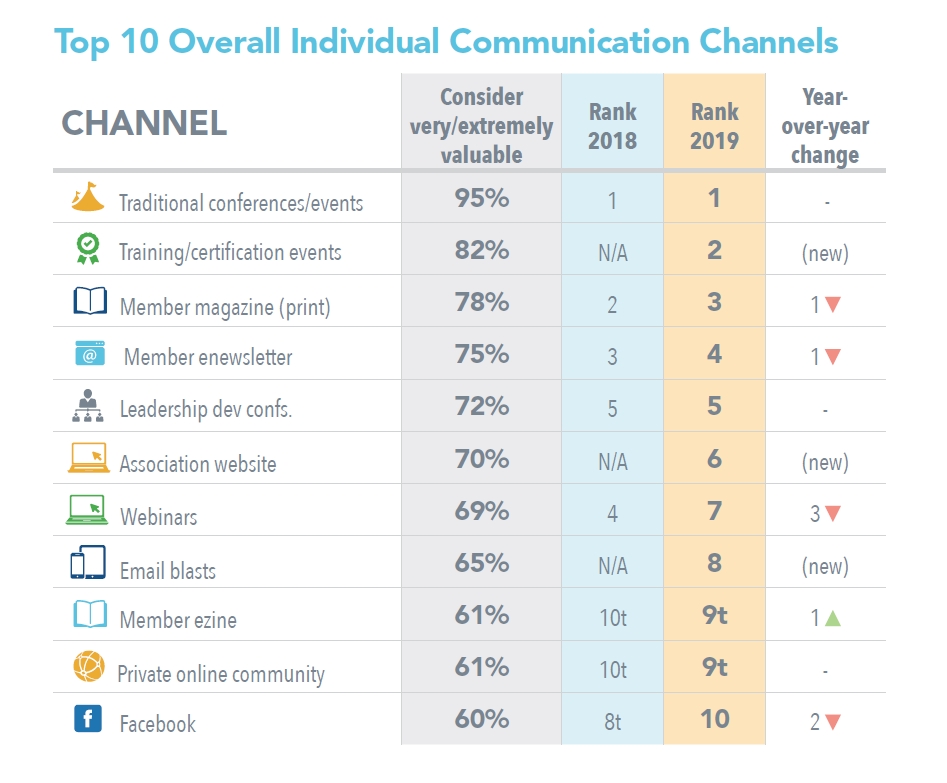Long Live Print: The Enduring, Original Communication Method
When actor Harold Ramis declared, “Print is dead,” in the 1984 blockbuster movie “Ghostbusters,” those words rang as prophetic. In many ways, he was right. Newspaper circulations are in decline. Tablets and e-readers continue to dominate the market. As we enter into a new decade, it’s clear that we have found our footing in the digital age. Yet printed communications continue to cling to relevancy in an increasingly digitally minded world.
The Lure of Communicating Digitally
The lure of digital communication is tempting for many reasons. E-newsletters, websites, webinars and email continue to remain in the top overall communication channels, according to the 2019 Association Communications Benchmarking Report.

And it’s for good reason. Communicating with members using technology is cost effective and customizable. Associations can easily segment their membership base to provide content specific to that member’s needs. Once the technology and content is in place, all it takes is the click of a button to send it to inboxes and show up on social media feeds.
But the appeal of digital communications does not limit itself just to associations. Nearly every organization and company has jumped on the digital bandwagon, and the digital communications landscape has become saturated. In the constant noise of email alerts, Twitter notifications and news pop-ups, it’s hard to cut through the clutter and stand out to your members. In fact, 70% of associations agreed that combating information overload and cutting through the clutter was a top communication challenge for them.
Going Full Circle with Print
It used to be that physical mailboxes were bursting with advertisements, coupons and magazines. Now, they are filled with literal spider webs as the arachnids make homes in the undisturbed, quiet containers, and it is our inboxes that are overflowing. It is for that reason that print is making a comeback. Hard copy newsletters, magazines and invites are few and far between, so when one arrives in the mail, it sparks a sense of surprise and intrigue.
Essentially, digital and print are going full circle and beginning to swap places. Whereas a member might have dumped a publication in the recycling bin without even glancing through it years ago, that same member now clicks the dreaded “Delete All” box (or worse, the “Mark as Spam” button) on their emails without so much as reading the subject line.
Meanwhile, a glossy magazine or eye-catching printed newsletter sits on the kitchen counter or desk corner where members can peruse it at their leisure. They may flip through the pages when they need a break from staring at the screen or while enjoying morning coffee. It is an item they can go back to multiple times to read different articles, jot down notes or highlight which upcoming events interest them.
Why Print Endures
Printed member magazines have consistently remained towards the top of association communication channels, with 78% of associations considering it very/extremely valuable. Besides the fact that it is now perceived as a more unique mode of communication, print communication has stubbornly endured because it provides something that digital has not yet managed to master: long-form articles.
Consider first the valuable information included in association communications. Often it involves explaining a process or regulation, detailing the history and significance of a topic. For many, it’s preferable to read long articles on paper instead of squinting at their smartphone.
While there are plenty of blog posts, web pages and emails that carry on for hundreds and thousands of words, the reader’s waning attention is easily pulled away, never to return. However, a printed article can retain its value. Whether a useful guide is dog-eared to be used again, a conference recap triggers a reminder to follow up on an introduction or a member profile proudly is displayed, print lives on.
In the end, associations should utilize print and digital communications to maximize their reach. Both play important roles in communicating with members and showcasing the association as a prime source for industry-related news and updates.


